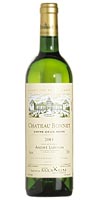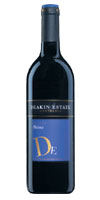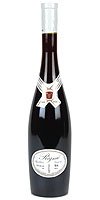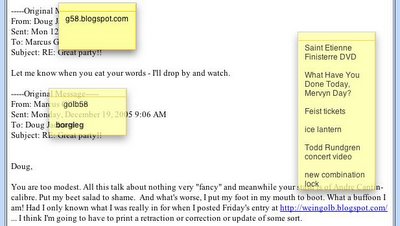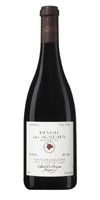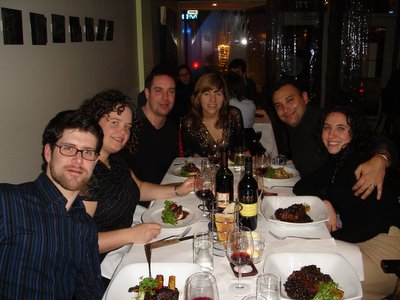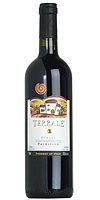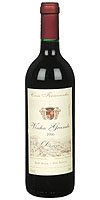Weingolb wraps up
It's in the can. 2005 is through -- and along with it, Doktor Weingolb's goal to publish on wine everyday. Every damn day is more how I see it after this December. I didn't know at the outset how much revision would be involved in getting out thirty posts of original material on a tight deadline. The last few nights I've been publishing in the waning minutes of the day, including a time or two like today's where I cheat a bit and assume Alaskan time to squeeze in a daily note. (What do you expect on New Year's Eve? Even wine bloggers have a bit of life!)
But don't let my work ethic fool you. I've been stimulated positively and I am proud of what I've gathered here. I stand behind my writing, though everyone makes mistakes. Sometimes I have to correct errors in entries after they've been published, but for the most part this blog has not been back-edited. I like that since it reads like a real tasting record -- a bit of a time capsule of what I drank and my reactions to it over a 48-hour period. I know I find the record valuable. It'll be an added bonus if other wine enthusiasts can go back and find use in reading When the chicken you're eating is actually a red herring, Signorina Affinità, How dumb was that? or Born in the Year of the Sun. Basically, wherever Weingolb displays a bottle, below it lies a full tasting report and suggestions on ideal food pairings. I am also proud of this utilitarian aspect. Keepin' the log in blog, folks.
I hope other reviews have put an emphasis on good value and wine events to take advantage of locally. These are write-ups like Rézin; How far does your wine budget go?; The best things in life are free, i.e. The art of living; and Vineland Estates vidal icewine and select late harvest.
While reviewing wine was the primary mode for this blog, I found the days without wine in between could be devoted to my inclination towards more humorous writing. I seized on Pain au vin nouveau as ideal fodder: a subversive assessment of Beaujolais Nouveau hidden within some food criticism of a bakery chain. In general, I have high hopes when writing about the pedestrian because it elevates the experiences that we all share. For example, those ubiquitous office parties. Toeing the office-party wine turned into a bit of soap opera when I needlessly chided my employer and had to publicly respond with the apologetic How to recant a whine. (Yes of course I like puns.) Other cheap attempts at a guffaw: The Great Underwater Wine and Cheese Party, "You're Soaking In It" and other things best avoided, and It's wise to depant before serving wine to certain people I know.
My personal reflections often require writing about the poeple around me. Luckily my friends don't mind the occasional skewering. Sometimes, I take further advantage by using lovely images from their digital camera. Such was the case with Bois de Boulogne, lunchtime, May 2004, a post on my last big vacation, which was to France, originator of so many of my favourite wines.
And there you have it. Now I'm on vacation from wines. I can barely believe it but it is true. I won't update here for a little while so the Doktor is out. Check his predecessor golb for new posts in the interim, particularly if you are looking for contemporary musical selections to go with your best New Year wine. I will be back here before too long. Happy new year!
Backwash: Wine of the year
Two days ago I christened a wine that costs less than $10 wine of the year. No problem there. The cost of the Peller Estates Cuvée Niagara Brut may not be prohibitive but as it turns out getting your hands on it is not exactly a cinch. The LCBO does not stock it like I said it did. Used to but no longer, which is unfortunate. Vineyards Estate Wines remains the best bet for getting ahold of it. I was also hoping to find a mention of it in Konrad Ejbich's A Pocket Guide to Ontario Wines, Wineries, Vineyards, & Vines, which I got in my stocking this year, but no such luck. I see he did talk about it almost ten years ago in this favourable profile. All the more reason to hype it some more here today.
Backwash: Wine of the month
When I see the opportunity for a end-of-term doubleheader I seize it. So here I will expand upon yesterday's review. In the time since I took my review notes for Château Bonnet Entre-Deux-Mers 2004 I've had the chance to resample this wine (we drank another bottle of it just hours ago on the train home from the Niagara Peninsula). On top of that, Bonnet made a shocking red-carpet appearance at our Christmas office party a few weeks ago. Point is, this wine always manages to make itself welcome. Without a doubt I would deem this selection the wine of the month for December. On that tasty note, I eagerly await January.


